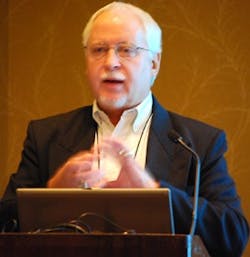Billions of Dollars at Stake in the Refinery of the Future
The refinery of the future will be better tied to the value chain, matching models to business requirements, said Dr. Martin Turk, Invensys' director, global industry solutions, HPI, at the 2009 Invensys North America Client Conference in Houston. "Outside of research and development, manufacturing is the only segment of an operating company's supply chain where value is added," he said. "Why is this important? The goal is to add value when you bring in materials, and manufacturing is the largest financial lever under an operating company's control."
Over the past 20 years, refineries have made consistent hardware and software upgrades, but the most important aspect of future refineries will be employees, knowledge, performance indicators and performance measurement, said Turk. "It is a journey, not a destination. We've seen the proliferation of digital sensors, and that will continue," he explained. "But understanding what's flowing in the pipes is really important in terms of maximizing the value of everything you do. By understanding what you're bringing in and knowing what your reactions and separation processes are doing, every time you break a molecule apart, every transformation should add value."
"Every time an operator makes a change, he ought to know whether he's making or costing his company money," Turk said. "For example, through its Molecule Management initiative, ExxonMobil claims to be on track to capture half a billion dollars a year in benefits."
The differences will be in how information is treated, with the ability to adaptively change access to information and controls, with the seamless flow of information between the plant and the enterprise and with information being proactively pushed to decision makers in context, rather than requiring them to find it and analyze it. "Reactive browsing will no longer be sufficient. You'll see a lot more proactive stimulus in the future. "Performance will be measured using multi-dimensional KPIs, like safety compliance vs. training hours or environmental compliance vs. throughput," said Turk.
"Operators need to become proprietors," he said. "The transmitter, the DCS and simulation software all changed clients' workflows. Integrated automation and ‘business control loop' systems will also change clients' workflows, which will in turn change when, where, how, which and why people team together to prevent or address problems and take advantage of opportunities. My dream is to be able to have the executives share goals with the business manager, who translates it to the plant management, who share it with the process management level, passing KPIs down from the executive level and performance measures up from the process-management level."
In the future, all facets of business intelligence will provide decision makers with experience-based and model-based guidance in real time, explained Turk. Automated, dynamic workflows will eliminate manual data processing and information reconciliation. "We capture knowledge, and we need to deploy that more," he said. "We need more model-based guidance to make more informed decisions, using models to give us a picture of what's going on. Now it's not just a number on a table. The operators and engineers of the future are gamers. They live in this virtual world."
Turk emphasized the need to recruit more young people to the profession because of the diminishing talent pool and the constant retirement of engineers, who are walking out the door with 30 to 40 years of knowledge and experience. "The future of the world is greatly dependent on science and engineering," he said. "Experienced knowledge workers in unique disciplines will be a rare resource and will be globally distributed. Few people want to live where the new energy discoveries are being made or where hydrocarbons are processed, and they don't want to work in hazardous environments. The fewer people we can have in a dangerous environment, the better we are. The next generation is accustomed to models and the use of simulators. There will be networks of training and collaboration centers around the world."
All information will pool into one federated view of data, and business intelligence will exist in the DCS, predicted Turk. "Giant data centers for advanced applications and new ways to manage telecommunications risks will be used," he said. "Everything will be delivered through a universal interface. Equipment and process performance management will be highly automated, context-sensitive and predictive in nature."
The drastic increase in I/O points over the past 25 years demonstrates Turk's point. "In 1985, you've got low I/O counts of around 5,000 and an I/O ratio of 3:1," he explained. "By 2005, I/O counts were at 60,000 with an I/O ratio of 8:1. The prediction we'd made for 2025 of I/O counts at 350,000 were woefully conservative. Those are already here today. Also, in 1985, you had operators on panel instruments and a lot of people running a process. In 2005, we saw the compressed console that can give the depth and breadth of information. In 2025, you'll have collaboration walls with multiple displays at the command centers. Conference rooms will become business management centers."


